
Compiled from over 20 years of experience.
By Tom and Dixie Stevenson

Little Friends Wildlife Center, Beaufort, S.C.
A Charitable Nonprofit Organization
Email: hornet@islc.net
South Carolina Licensed Wildlife Rehabilitators
Permission given to copy if unedited and distribution is free.

WARNING! WARNING! WARNING!
Raccoons are classified as a Rabies Vectored Species (RVS). Every raccoon has the potential of being infected with the rabies virus and therefore requires special handling. Typically, Wild Life Rehabilitators are vaccinated to protect them against the virus. For this reason, we recommend that ALL baby raccoons be turned over to an experienced rehabilitator. Since the virus is only present in the saliva of an infected animal and can only be transmitted directly into the blood stream of a human, extra care should be taken to prevent raccoon saliva from comming into contact with open wounds, scratches, inside the mouth and nose, and eyes of humans. Alway wash after handling a raccoon, as you should after handling any animal.

Before attempting to care for a baby , try to find a licensed
rehabilitator with experience raising raccoons to take the baby. Call a Vet's Office and ask, or contact your state Department of Natural Resources for a rehabber in your area. If you cannot find a professional to take the baby, then follow these instructions to the letter, and if the baby you have found has no hidden injuries or death inducing trauma, you will successfully raise it to release.
EMERGENCY TREATMENT
Read Each Section Before Acting
Step 1: Get the Baby Warm............................Section A.
Step 2: Hydrate................................................Section B.
Step 3: Treat Wounds & Other Conditions....Section C.
Step 4: Get the Right Formula and Feeder.....Section D.
GENERAL INSTRUCTIONS
Bathroom Business
How Old Is My Baby?
Sex - Boy or Girl?
Weaning and Diet
Metabolic Bone Disease (MBD)
Release
Raccoons Are Not Pets
NOTE: A healthy baby raccoon, will have soft, smooth, and shiny black skin on the bottom of its feet, with pink gums and lips; it squirms, responds to touch, feels warm, and is fat and round. It will likely be crying for food and generally will attempt to nurse your finger. A dehydrated or cold baby has dull grayish colored feet and pale gums and lips; it will ball up, be unresponsive, sluggish or lie still; it will look thin and feel cold to your touch. The skin on it's feet will be slightly wrinkle.
A. GET THE BABY WARM! (read and do now before going any further)
A baby raccoon should feel much warmer than your skin. If it feels
cool to your touch then it is cold. Hypothermia will kill. Do not
attempt to feed a cold baby. Even though the baby may be fully furred, it does not produce enough body heat to warm itself until it's four to six weeks old. A baby that is sick or injured will need a heating source. Wrapping it in a blanket will not suffice since the baby cannot warm the blanket. You must provide a constant heat source. The most dependable and accessible is an electric heating pad. Temporary heating, until a pad is found and the nest box warmed, can be supplied by filling a zip lock baggy with hot water and putting it under a blanket with the baby in the blanket. Do the following: turn the pad on low , place it on a table; get two bath towels, making sure there are no loose strings on them: fold one in half and lay on the pad; rumple the second towel and put it in the nest box (bigger and taller than a shoe box with flaps that can be folded over. No matter how small, these babies will climb and you may find it cold as ice in a corner of the room if there was no top on the container. The top helps hold in the warmth and should have air holes of course. If you have a single baby, put a soft stuffed toy in the container with it. Placing the nest box half on and half off the pad will provide a cool place if the baby becomes too hot in one area. Place the container and heat source in a quiet and dark place. Now go on to step 2, section B.
Top
B. HYDRATE THAT BABY!
The most important treatment you will give the baby raccoon you have
found is hydration. Do not start the baby immediately on full formula,
even the right one - hydrate first. Any baby has encountered trauma by
being separated from Mama: the separation may have been a few hours or
a few days. The smaller the baby, the greater the risk of dehydration
and if you do not rehydrate you will lose it. Even the healthiest
looking babies should first be hydrated.
Why is hydration so important? Water is essential for the digestion
of food: fluid is pulled from the body's cells during the digestive
process. If the fluid in the body is low, then there is not adequate
fluid for digestion and the baby's reserves are drained. Additionally,
the baby's body is accustomed to Mother's milk and introducing a new
food can cause diarrhea, leading to further dehydration. Soon, without
hydration, you can have a thin , dry, grayish looking little mummy
instead of a precious, fat, round, plump baby. If you have already
given a milk of some kind, then start over. Hydration Instructions:
Most people immediately give the new baby milk of some kind. Don't do
it. A baby will not starve to death over a 24 hour period, but it can
sure die of dehydration. Hydrate first. Here's how: to Pedialyte, add a small amount of Puppy or Kitten Milk Replacer (Esbilac or KMR provide the best results). If pedialyte is unavailable, mix a little salt in water (salt is an electrolyte). If milk replacer is not available, use 2% milk and administer with a syringe or eyedropper. Mixing a drop or two of milk replacer in with the water will make it more acceptable to the baby. Cow's milk, Goat's milk, or human baby formula should not be used for long term feeding.
Over several hours continue to give the water mix until you see an
improvement. Remember - only a drop or two of the milk per ounces - it is for flavoring only and too much will further dehydrate the baby. If the baby is unmoving or cannot drink, take it to a vet and ask him or her to inject lactated ringers subque (under the skin), then continue the hydration schedule at home until you see an improvement. Transport the baby with a hot water bag under a blanket - it will be cold when
extremely dehydrated.
If you think the baby is moderately dehydrated, use a 50/50 formula to pedialyte mix; give pedialyte even if you think the baby is not
dehydrated. If proper formula is not available use Pedialyte with 2% milk mixed as above. Do not start any baby on full strength formula. Always hydrate first and then gradually introduce the formula as described under formulas. Again, dairy products should not be used for long term feeding.
Now, between times of offering the baby the rehydration fluid, read
the rest of the instructions, then get the recommended formula and
feeder.
Top
C. TREATING WOUNDS AND OTHER CONDITIONS - The Most Commonly Encountered
1. CAT & DOG ATTACKS- Cat bites kill and must be treated with a wide spectrum antibiotic such as Clavamox (safe and contains clavalanic acid as well as amoxicillin). Obtain this drug from your vet. Don't accept amoxicillin alone - it will not kill the gram negative bacteria that is in a cat bite. Clean all punctures by flushing with betadine. Hydrogen peroxide is a poor anti-bacterial flush. Dog bites can be treated with a wide spectrum antibiotic such as Clavamox or with amoxicillin. Obtain this drug from your vet. Clean all punctures by flushing with betadine. Apply an antibacterial ointment such as Neosporin.
2. OPEN WOUNDS OF AN UNKNOWN SOURCE- Because Raccoons are a Rabies Vectored Species (RSV), open wounds around the head and hind quarters that are caused by an unknown source, (i.e. not a cat or a dog) may indicate an attack by a rabid animal. Any baby with wounds from an unknown source should be treated as though they have been exposed to rabies. We do not recommend that anyone without adequate protection from rabies, attempt to rehabilitate a raccoon. Rabid raccoons pose a serious threat of death to a human if not properly handled. Always avoid bites and scratches that break the skin by the animal, and if you have open wounds, do not expose yourself to the saliva of the animal.
2. HEAD INJURIES with major swelling are more difficult because a steroid such as dexamethazone should be administered to reduce pressure and damage caused by swelling of the tissues and fluid. This drug can be dangerous if not used properly. The proper dosages should be observed and given for 3 to 5 days.
The animal must be withdrawn slowly, with decreasing dosages, or it
will die from the withdrawal. A liquid form is available. It is
obtained from a vet who will advise you on dosages. A baby with a head
injury will fall or drift to one side, and carry the head to that
side. The swelling from the injury will probably be noticeable, however, in some cases it may not be. Look signs of head injury such as blood in the nose or ears.
3. A FRACTURED LEG- Raccoons are very resilient and can survive falls from very high places with very little injury, as long as they don't fall on hard surfaces such as concrete. Unless it is a complete break and the leg is misaligned, it should not be taped. Taping can cause many problems and the baby will grow so fast that a fracture should heal before the baby is old enough to be up and about.
4. Fly Eggs & Maggots: During summer months, many babies come in with fly eggs or maggots in open wounds, their eyes, ears, nose, or just about any other open cavity. These should be removed with a Q-tip or by other means. In some cases, the maggots may have developed to a point that they form large lumps under the skin and must be lanced and the maggot removed with tweezers. Always remove as much of the maggot as possible. Though the raccoon's body can absorb some of the maggot remains, excessive amounts of a dead larger maggot can be toxic and kill the baby.
IF YOUR BABY HAS DEFORMING INJURIES that would prevent its later release, then do the kind and loving act of freeing it from suffering through euthanasia. Your vet will aid you in this. A raccoon who cannot run free is a raccoon deprived of its essential nature and you will always be a warden tending a prisoner.
Top
D. FEEDER, FORMULA, and INTRODUCING FORMULA TO THE BABY
Feeders- The right feeder depends on the size and age of the baby. A syringe, in the sizes of 1 to 3 cc syringes for a baby less than a week old, a baby bottle with a New Born nipple for 1 to 3 week old, and a normal baby nipple for 3 weeks and up.
PET NURSER BOTTLES - These bottles come in several sizes. The ones with larger nipples can be used. However, do not make the hole to large. If the hole is to large, you can aspirate the baby with a bottle (get milk in the lungs, causing pneumonia or outright drowning). The proper sized hole will give a stream of formal about the diameter of a large paper clip when the bottle is squeezed.
Formula: The right formula is Esbilac Powder Milk Replacer for
puppies or KMR Powdered Milk Replacer for kittens.
Accept no substitutes! Not even if a pet store clerk or a vet tells you the product they sell is the same - it isn't. Wildlife has special dietary needs - many products advertise that they can be fed to
raccoons and other wildlife - that doesn't mean they should be fed to
raccoons and other wildlife. Esbilac is expensive and sometimes hard
to find, but if you are going to the trouble to love and care for this
baby and raise it to freedom, why subvert your efforts with a formula
that will kill it? Do not use human infant formula, goat's milk,
evaporated milk, or other cow's milk products. The protein, calcium and vitamin contents, as well as other nutrients are too low or missing to sustain the baby, and lactose causes diarrhea in raccoons. Mix and handle the formula as follows: 2 parts of hot (from the tap, do not boil) water, 1 part of Esbilac powder, a one inch line of Nutra-Cal vitamin supplement paste per cup of formula, and 1 tblsp of apple juice per cup of formula (this helps prevent diarrhea). Mix in a small jar what you think you will use in 2 to 3 days. Refrigerate mixture and the remaining powder, too. Warm only what you will need each feeding
to a little better than room temperature. It should feel warm on the inside of your arm. This is your full strength formula and should be used through weaning.
Feeding Schedule: Do not fail to follow the schedule below. This schedule will continue hydrating the baby and also will introduce the formula gradually so that the baby doesn't react adversely to a new
food. Most babies will immediately begin nursing a bottle, however, there are exceptions and these babies must be taught to nurse. Some will chew at the nipples but won't nurse. By squeezing the bottle, you can get the formula taste in the babies mouth. Gradually move the bottle to the front of the baby's mouth. Wrap your fingers around the baby's snout and gently hold it closed on the nipple. Continue to squeeze the bottle but stop when the baby starts to suck or formula runs out the sides of the mouth. This may take several sessions before the baby will nurse on its own.
Feeding #1
Fill the syringe or bottle with no less than 5% of the baby's weight of hydration formula (Pedialyte with a little formula flavoring). Give the baby all it wants. Refill if necessary.
Feeding #2
Same as first.
Feeding #3
Same as first except mix at 3/4 to 1/4, Pedialyte to formula.
Feeding #4
2 cc's of the formula - add 1 cc of plain water.
Feeding #5
Same as first except mix at 1/2 to 1/2, Pedialyte to formula.
Feeding #6
Same as first except mix at 1/2 to 1/2, Pedialyte to formula.
Feeding #7
You have reached full strength formula which you will continue to
feed. The baby should now be sucking enthusiastically, and when finished eating, sleeping satisfied and quiet with a little round belly.
HOW OFTEN DO I FEED THE BABY?- Do I have to get up at night?
Tiny babies, less than 2 weeks old, can only ingest small amounts per
feeding (typically only about 5% of their body weight), so more feedings are necessary. He or she should be fed about every 2 to 3 hours from when you get up until your bedtime. About getting up at night: ideally, a tiny baby would be fed twice a night, but most of us must work and sleep is necessary for us to function; if you are tired and your boss is angry because you are late to work, then you will feel pressured and the baby will suffer. Be diligent during your waking hours, and the baby should be alright. If the baby is dehydrated or sick then you should give nightly feedings until it is fully recovered.
As the baby grows and can ingest more formula (at 2-3 weeks they will eat about 1 ounce) at each feeding, the times between feedings can be increased until, at approximately 5 weeks of age, you are feeding it every 6 to 8 hours. By 6 weeks you can reduce feeding to twice a day and at 7 weeks, begin to offer small amounts of dry cat chow and fruit between bottles. As the baby goes through weaning and is ingesting increasing amounts of solid foods, you can decrease to a single feedings per day until the baby is eating only solid foods and has rejected the formula - this rejection will typically occur sometime between 10 and 12 weeks. Of course there are exceptions and some will never reject the bottle so by 14 weeks, discontinue the bottle.
Top
BATHROOM BUSINESS
An infant raccoon should be stimulated to urinate and defecate every
time you feed it. Failure to do so can cause uremic poisoning. All
mother mammals lick their babies to initiate this process, and to keep
their babies clean. A baby will leak on him or herself but this is not
the same as voiding a bladder. And also, an unclean baby will get
diaper rash, urine burns, on its tender belly. Stimulate by tickling
the babies genitals with a cotton ball or other soft, absorbent
material such as toilet paper.
When you first get the baby, its stools will be a firm dark brown.
Within 24-36 hours of feeding formula, the stool will change to a mustard brownish color; it should remain firm. If it is runny, then you have diarrhea. Add pedialyte to the formula for a couple of feedings (about 1/2 pedialyte, 1/2 formula) then continue with full strength formula. Do not repeat adjustment to formula. The baby might have been slightly dehydrated. Another reason for runny stools is overfeeding. A baby's belly should never look bloated after feeding- it should be nice and round. If the diarrhea does not stop in 24-48 hours, it may be serious. Take it to a vet.
Top
HOW OLD IS THE BABY?
| 1 to 5 days - body is 2-3 inches long. Skin color will be reddish brown in color. Eyes and ear channels closed. Ears will have no hair and lay flat agains the baby's head. Thin hair over most of its body. Face, belly, and underside of legs, and feet from knees down have no hair. Normal weight is 50-80 grams.
|
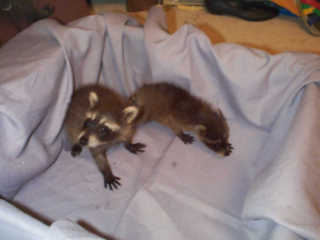 |
| 5 to 10 days - development of soft, reddish brown, sable hair around nose, mouth, and tops of the feet. Stipes on tail just begin to be visible and hair will now be purpendicular to the tail but very sparse. Skin color will move more be more toward a dark grayish brown. Body is 4-5 inches in length and the normal weight is 80-100 grams
|
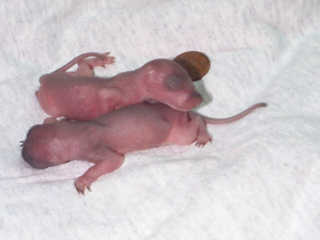 |
| 10 days to 2 weeks -
|
 |
| 2 weeks to 3 weeks - body (less the tail) will now be 8-9 inches long. Weight will be 350-400 grams. Ears will have very fine hair on the back side with a very thin line os silver on the tips. The ears will now be floppy but still don't stand up. |
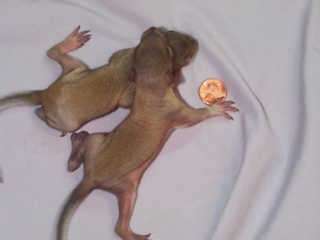 |
| 3 weeks - the baby's lower front teeth begin emerging. Hair is now slick, smooth, and shiny. still no hair on legs and belly.
|
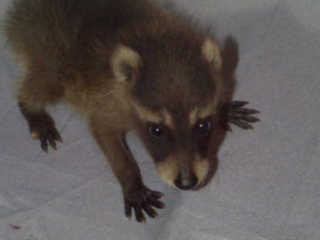 |
| 4 weeks - has light grayish-brownish hair all over, except lower legs and belly and under tail. Some downy white hair beginning on belly and legs. |
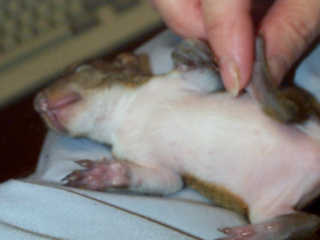 |
| 5 weeks - thicker hair, including legs and belly. Tail hair is short, straight, and lies parallel with the bone. Eyes open. |
Picture Comming Soon |
| 5 to 6 weeks - upper front teeth begin emerging. Begins curling tail over back.
|
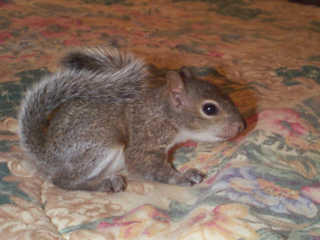 |
| 6 to 7 weeks - fully furred, sleeping less with more active periods.
|
Picture Comming Soon |
| 7 to 8 weeks - tail is fluffy. Should be placed in a cage with plenty of room to play.
|
Picture Comming Soon |
| 8 to 9 weeks - looks like a miniature raccoon. very active and
shredding your sweaters, curtains, furniture, and arms with its claws.
has lost infant appearance.
|
Picture Comming Soon |
| 9 to 10 weeks - develops more muscular physique.
|
Picture Comming Soon |
| 10 to 12 weeks - about 3/4 full size - release at 12 weeks.
|
Picture Comming Soon |
Top
SEX - Is My Baby a Boy or a Girl ? Added by Tom Stevenson.
Because we've heard this question so often, I decided to add a photo that best shows the difference. From the very youngest, to those old enough to release, one can always distinguish male from female. In the photo below, the baby on the left is obviously a male and the one on the right is a female.:
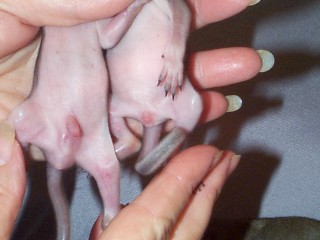
Hopefully this will help when the time comes to determine if your baby is a boy or a girl.
Top
WEANING and DIET
The baby's eyes open at 5 weeks but they don't see well at first and
nothing about their behavior will change for another 5 or 6 days; they
will still eat and go back to sleep immediately. At some point during
this period of time, begin gradually introducing some baby cereal to
the formula; start out with just a few grains and if you see no
adverse change in the stool then add a little more with the next
feeding and so on. Do it gradually.
At 6 weeks put a couple of grapes and a few pecan pieces in with the
baby. It will begin gnawing the pecans and sucking the grapes (don't
cut the grapes into small pieces - put in whole - a baby can suck a
grape piece into its throat and choke). Gradually thicken the cereal
mixture until it is too thick to pass through the syringe. By this
time the baby will love the taste and will also be old enough
(approximately 7 weeks) to start licking it from a jar top. Add some
baby applesauce or pears to the formula/cereal mixture when you offer
it in a jar lid. This eating of cereal is a messy and humorous affair.
The baby sucks it instead of licking. Keep a wet towel handy to wipe
the baby's face, chest, and head as it will practically swim in the
cereal. Give the cereal mix several times a day in addition to some
fresh apples, grapes, or pears, and fresh corn on the cob. Fresh corn
is a good food to offer because it has protein and calcium, is soft
enough for little teeth, and the babies like it.
As the baby grows and becomes more active, offer other raw foods such
as broccoli, sweet potatoes, and carrots. At approximately 8 to 9
weeks the baby will be able to open sunflower seeds. Get the large
stripped sunflower seeds - do not give salted seeds. If a pet store
near you has rodent chow or monkey biscuits, add that to the diet.
Always have fresh foods in the baby's cage in addition to rodent chows
and sunflower seeds.
raccoons will chew on deer antler or old dry dog bones from the
yard. Add either to the cage and it will be a good source of minerals
and help strengthen teeth and jaws.
About peanuts and pecans: pecans are only used to entice first
munching. Pecans and peanuts are not food, they are candy with the
nutritional content of Snickers Bars; in other words they have no
nutritional content. A raccoon fed a diet of pecans and peanuts will
develop metabolic bone disease (a lack of calcium and minerals), begin
having seizures around 2 months, (you may not notice the seizures because
they are at first very short and mild and may take place when the baby
is out of your sight), and will die before 3 months of age. Give
pecans and peanuts sparingly as hand treats.
Top
Metabolic Bone Disease (MBD)
Metabolic Bone Disease (MBD) is caused by an improper diet that is deficient in calcium/phosphorus. The condition leads to death or
paralysis. A diet consisting primarily of peanuts and pecans will
surely cause MBD. Calcium is necessary for the development of bones, muscles, eyesight, and other organic functions.
Symptoms of metabolic bone disease: the raccoon begins having seizures between 2 and 3 months old (you may not notice the seizures because they are at first very short and mild and may take place when the baby is out of your sight). Paralysis may or may not appear at this time, but will surely appear at some point. The animal will sometimes be obviously in pain, crying, or stiff with limited motion. There will sometimes be a drop in appetite. If the condition goes untreated, the raccoon will die. MBD is very common because people do not provide a proper diet. A proper diet consists of a variety of foods as has already been mentioned. Variety is key here: do not give too much of one food. For example, corn, although containing calcium and protein, is not sufficient unto itself and too much of corn will lead to deficiencies. Rodent chow (also known as monkey biscuits or parrot biscuits) is balanced with the proper nutrients and should be part of the diet.
Treatment for MBD: get calcium/phosphorous into the raccoon
immediately. The most readily available source can be purchased from most vets and is called Pet Tabs. Pet Tabs have a blend of minerals and vitamins. Grate the tab into powder and administer 1/4tsp daily. Try rolling the powder in a small ball of peanut butter, or, if necessary, dilute in a small amount of water and force feed with a syringe. If the symptoms are severe, take the animal to a vet and ask for a calcium injection, then continue treatment with the Pet Tabs. Your vet may have another product containing calcium that he or she recommends. Be sure that the product has calcium/phosphorus and is not just a vitamin supplement. You should see positive results in a few days. Be sure to change the diet.
Top
RELEASE
There is a special and simple way to successfully release the raccoon
you have nurtured. Don't just take it to a tree and let go; The
raccoon may reach your back door before you do, begging to come in.
That he is begging to come in doesn't mean he is rejecting his
birthright: it means he is unfamiliar with the outdoor territory.
raccoons have home ranges in which they know every tree, rock, and
bush, dog and cat. Take them to another area and they are completely
unnerved and afraid.
Provide a support system for your baby until he or she has adjusted
to new surroundings and is comfortable outside. Your baby must learn
to interact with its own kind as well as learn about its new
environment. Put the cage outside a week or so prior to your release
date. This will introduce the baby to outside temperatures, sounds,
and daylight/nighttime schedules gradually. Place the cage in a
protected area such as a screened porch, a covered patio, carport,
etc. Make sure cats and dogs cannot reach the cage. You could even
hang the cage high in a tree. Protect the cage from rain and too much
direct sun. Continue putting food in every day and talking and
touching the baby to reassure it. It will be very frightened at first
and will probably hide in the nest box for a day, but will eventually
come out. You can even, in the case of extreme fear where the baby
crouches panting and squealing in the cage, move the cage out of the
house every day for a few hours until the baby is comfortable outside.
Then leave the cage outside all the time, including nights.
One day, when the raccoon is scampering all over the cage, and the
weather will be mild for several days, open the door and let it find
its way out. Do not remove the cage and keep food and water and the
nest box in the cage. He or she will come and go from the cage for
awhile until it has built a nest or taken over an old one.
Top
RACCOONS ARE NOT PETS
raccoons are wonderful babies and can be vicious adults. In most
states it is illegal to keep them and if caught a person could pay a
big fine. They have no domestic instincts, they do not love and they
do not feel loyalty; they have no pack or herding instincts, and are
by nature solitary creatures. Do not allow yourself to confuse their
natures with those of dogs and cats. raccoons have special dietary
and spacial needs that are difficult to satisfy. Mature raccoons are
unpredictable in mood, do not forget or forgive mishandling, and will
bite even the hand that fed it and kept its bottom cleaned. Do not
believe the stories you hear or read which imply raccoons are
wonderful pets - they are not.
raccoons are creatures of pure instinct with very strong defenses.
Their bodies are designed for trees and dirt, not houses and cages.
They will shred your curtains, urinate and defecate anywhere they
happen to be, claw the skin off your arms, bite you, and if kept in a
cage will develop mindless routines of movement. You will become a
warden tending a prisoner. There is nothing more heart rending than
to see a raccoon hanging on wire or screens longing for something it
cannot name but wants so intensely. The raccoon is driven by
instinctive emotional and physical needs that cannot be satisfied in
captivity and that cannot be changed.
Releasing a raccoon will relieve you of the day to day responsibility
and the pain and guilt you will feel when the raccoon you have loved
and nurtured dies in captivity. And die it will - because of poor diet;
because it bit somebody and was thrown against a wall; a child injured
it or it injured a child; someone moved a sofa and crushed it; slammed
a door when it was sitting on top of the door; or it drowned in a
toilet. A raccoon you raised and who lives in your backyard is a happy
raccoon that will come to you and take treats; it may even come in and
out of your house. You can have a relationship with a free raccoon that you cannot possibly have in captivity, a relationship that is based on respect and admiration and not on selfish possessiveness.
Love and nurture the baby you have found, and after giving life, give
the greatest gift of all - the freedom to enjoy that life. The first
time you watch your baby scamper up a tree you will feel the rightness
of it, you will see its unbounded joy. You will profit from one
additional aspect of freeing your baby and that is a feeling of
participation in the natural world by giving back to Mother Earth one
of her own.

Return To raccoon Page.

![]()








